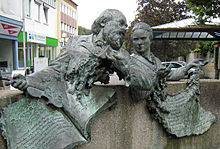Maria Zanders

Maria Zanders , née Johanny-Abhoë (born March 9, 1839 in Hückeswagen , † December 6, 1904 in Bergisch Gladbach ), was a German paper manufacturer and an important donor of culture.
Life
Maria Zanders was the daughter of the cloth manufacturer couple Julius and Charlotte Johanny. She was brought up in an elegant boarding school in Düsseldorf . Her birthplace is on Marktstrasse in Hückeswagen . On June 17, 1857, at the age of 18, she married the paper manufacturer Carl Richard Zanders from Bergisch Gladbach. The marriage had four children, including Richard Zanders .
The paper manufacturer
After the untimely death of her husband in 1870, she saw it as her most important task to continue running the JW Zanders paper mill and thus to keep it for her children. The world exhibition in Vienna in 1873 brought the company the Medal for Progress in recognition of its hard-working development, to which the deceased husband undoubtedly also contributed. In 1876 Zanders bought the paper factory in Dombach, today the Alte Dombach paper museum . In addition to further purchases and new plants, there was a further expansion of the straw material factory. In 1881 735 workers were employed. In 1886 the two sons Richard and Hans Wilhelm joined the company.
The art patron
From 1873 to 1874, Maria Zanders had the representative Villa Zanders built in the center of Bergisch Gladbach based on designs by Hermann Otto Pflaume . Important artists and scholars frequented their hospitable house, among them the composer Max Bruch , the painter Carl Ludwig Fahrbach and the graphic artist Alexe Altenkirch . She also maintained contacts with other artists, such as B. Gustav Pfarrius , Heinrich Kruse , Paul Heyse , Julius Rodenberg , Wilhelm Wehrenpfennig and Eduard von Simson . She learned to use brushes and palettes herself and, under the guidance of Carl Ludwig Fahrbach, created the atmospheric biblical landscapes that can be viewed in the council chamber of Bergisch Gladbach town hall.
The Altenberg Cathedral , the gem of the Bergisches Land , was particularly close to her heart. On July 20, 1894 she founded the Altenberg Cathedral Association. Previously, in an appeal on November 13, 1893, she had addressed large parts of the population of the Bergisches Land and asked for help in the renovation of the cathedral.
Honors
- In June 1980 the green area between the Forum, the Paasweg and the Bergisches Löwen was named Maria-Zanders-Anlage .
- A monument has been erected to her in the center of Bergisch Gladbach
Individual evidence
- ↑ Family tree of the Zanders family
- ↑ a b c Festschrift Hundred Years of JW Zanders Paper Factory 1829–1929, Bergisch Gladbach 1929
- ^ Altenberger Dom-Verein eV
- ↑ Font: The Bergische Dom in Altenberg im Dhünntale , Bergisch Gladbach 1893
- ^ Andree Schulte: Bergisch Gladbach, city history in street names, Bergisch Gladbach 1995, ISBN 3-9804448-0-5
literature
- Ferdinand Schmitz : The paper mills and paper makers of the Bergisch Strundet valley , Bergisch Gladbach 1921
- Anna Caspary, Maria Zanders, The life of a mountain woman , published by Eugen Diederichs in Jena in 1929
- Egon Wolff, Edgar Königs and others: 125 years of JW Zanders 1829–1954 . Bergisch Gladbach 1954
- Thanks to Maria Zanders, celebration and speeches for the unveiling of her memorial stone at Altenberg Cathedral October 14, 1956 , Altenberger Dom-Verein eV 1956
- Klara van Eyll : 400 years of paper mills on the go . Bergisch Gladbach 1982
- Heinz Koch: Zanders, From the history of a company , Bergisch Gladbach 1989
- Hildegard Neuhauser: Music maintenance in Bergisch Gladbach in the 19th century. The entrepreneur Maria Zanders and the composer Max Bruch , Fernwald: Musikverl. Muth, 2004, ISBN 3-929379-12-0
Web links
| personal data | |
|---|---|
| SURNAME | Zanders, Maria |
| BRIEF DESCRIPTION | German entrepreneur and founder of culture |
| DATE OF BIRTH | March 9, 1839 |
| PLACE OF BIRTH | Hückeswagen |
| DATE OF DEATH | December 6, 1904 |
| Place of death | Bergisch Gladbach |

